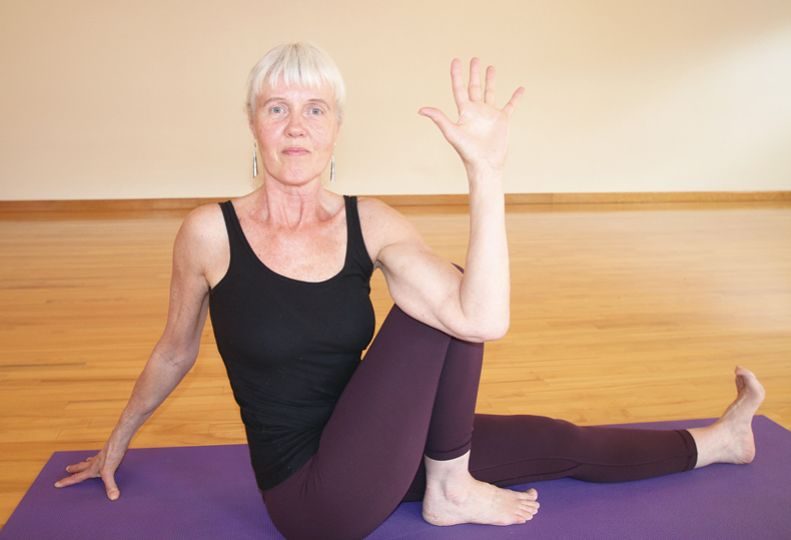
Home » Boomer yoga
Boomer yoga
Exercise method said to help with injury recovery, prevention

April 27, 2017
Harmony Yoga LLC owner Alison Rubin says practicing yoga in the advanced years of life can have lasting benefits in both injury prevention and recovery.
Rubin, who was born in Great Britain and emigrated to the U.S. in 1972, owns and operates Harmony Yoga on the lower South Hill, at 1717 W. Sixth. The business operates in 1,400-square feet of leased space and has been located there since 2002.
Prior to that, she had been operating as Life Dance Yoga in a variety of spaces since she moved to Spokane from Los Angeles in 1983.
Now, at 63, Rubin says practicing yoga has probably become more important than ever for her body.
“I’ve had cancer, had a hysterectomy, and no shortage of injuries to go along,” says Rubin with her British accent.
“Yoga can bring back your mobility and agility. We don’t value being able to bend down to a knee and tying a shoelace until we can’t do it anymore,” she says. “You don’t have to lose range of movement just because you’re getting older.”
Rubin teaches yoga instruction to students of all ages ranging from beginners to advanced students. Harmony Yoga offers a dozen different yoga classes, some of which include restorative yoga, designed to help improve the central nervous system, and power vinyasa, used for building the cardiovascular system and improving overall body strength.
And in recent years, Rubin, who is also certified to teach yoga instructors, has created more classes aimed for maturing bodies. The classes have included learning the basics of yoga, yoga for students 50 and over and gentle yoga, which she says are more passive and relaxing styles of yoga practice.
“Our studio is known for its slower, more mindful and therapeutic approach to teaching and learning yoga, which I believe is the most appropriate style for the older generation,” Rubin says.
“This slower style helps to prevent injury and allows time for students to align themselves in the poses and thereby gain the most benefit,” she says.
Rubin has 10 independent instructors at Harmony Yoga, which offers more than two dozen classes per week, Monday through Sunday. She estimates her studio draws 200 to 250 students per week, and says her longtime customer base includes between 300 and 400 people who are actively engaged, practicing yoga on an annual basis.
Ironically, she says baby boomers are among the largest group of newcomers to the practice of yoga. Rubin estimates 60 percent of her client base are seniors.
“I think a lot of that has to do with our style of teaching yoga. It’s a slower, more methodical pace, and we offer lots of basic classes,” she says.
Reflecting back on her impressionable years in England before emigrating, Rubin says, “Yoga was part of the hippie culture then. I was a spiritual seeker, and I found yoga trying to find answers to questions I had about life,” she says.
“It helped me land on a spiritual path, made my body feel good, and I thought, ‘It works for me,’’’ she says.
After she and her husband had the first of their three children, the couple decided to move from Los Angeles to Spokane after having visited friends here once.
“We moved here in 1983, and there wasn’t a yoga teacher, let alone a studio, to be found. I quickly realized that we weren’t in Southern California anymore,” Rubin says with a laugh. “Yoga was still largely an underground practice that wasn’t respected and carried a stigma about it.”
Rubin says she had to get creative in her attempts to establish herself as a yoga teacher and eventually open and operate her own studios.
By the late ’80s and early ’90s, Rubin had moved her way into some fitness gyms and athletic clubs under the guise of teaching “power stretching,” she says.
“I helped the Spokane Club set up its first yoga classes calling it power stretching. I don’t know if anyone knew that I was teaching yoga,” she says.
The practice of yoga gradually moved into the mainstream, buoyed by the efforts of the nonprofit, Arlington, Va.-based Yoga Alliance established 20 years ago. The alliance helped establish teaching standardizations for instructors.
Today, the alliance has more than 76,000 registered yoga teachers, more than 5,000 registered yoga schools, and more than 7,000 yoga alliance continuing education providers. Now, yoga is more widely accepted than it ever has been.
Rubin declines to disclose Harmony Yoga’s annual revenues, however, she says teaching and operating a studio has helped provide her family with a good living.
The proliferation of yoga studios and more instructors in Spokane, Rubin says, brought to an end the monopoly she once had not long after moving here.
“I don’t want to use the word competition, because that’s a very unlike-yoga trait, but there is more yoga being offered so there is more competition and customers have more options than ever before,” Rubin says.
“It’s not enough to get good training. You very much have to have marketing savvy,” she says.
This weekend, Rubin will lead 11 students on a three-day silent retreat 25 miles outside of Spokane. Attendees are encouraged not to talk with anyone, and all yoga is conducted in silence, Rubin says.
“I’m the only one that will be talking as I’m leading the workshop,” she says. “It’s a wonderful exercise designed to help people slow down and meditate. We even eat in silence.”
“Even though I’m the instructor, it’s super relaxing for me,” she says.
Latest News Up Close Health Care
Related Articles




